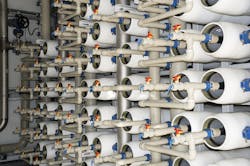Today’s industrial wastewater managers face an overflowing plate of immediate and long-range challenges. Among the many obstacles that lie ahead, there are a few overarching themes that figure to impact industrial water & wastewater going forward. Here I highlight five key trends that industrial water & wastewater managers need to be mindful of now and into the future.
1. Water security
According to the U.S. Environmental Protection Agency, improving the security and resilience of drinking water and wastewater infrastructures is vital to ensure the provision of clean and safe water. Along that line, the EPA is taking significant actions to:
- Assess and reduce consequences, threats, and vulnerabilities to potential terrorist attacks;
- Plan for and practice response to natural disasters, emergencies, and incidents; and
- Develop new security technologies to detect and monitor contaminants and prevent security breaches.
It is important for drinking water and wastewater utility managers, board members, elected and appointed officials to understand the benefits of investing in preparedness, prevention and mitigation activities. Unfortunately, the mindset of many field managers is: "My water requirements are satisfied, therefore my water is secure." With the range of risk factors currently facing water and wastewater, this attitude is dangerous and irresponsible.
2. Climate change
Water resources are important to both society and ecosystems. We depend on a reliable, clean supply of drinking water to sustain our health, and water is also needed for agriculture, energy production, manufacturing, etc.
Many of these uses put pressure on water resources, stresses that are likely to be exacerbated by climate change. In many areas, the U.S. EPA says climate change is likely to increase water demand, while shrinking water supplies. In other areas, water shortages will be less of a problem than increases in runoff, flooding, or sea level rise. These effects can reduce the quality of water and damage the infrastructure that we use to transport and deliver water.
The water cycle is a delicate balance of precipitation, evaporation, and all of the steps in between. Warmer temperatures increase the rate of evaporation of water into the atmosphere, in effect increasing the atmosphere’s capacity to "hold" water. Increased evaporation may dry out some areas and fall as excess precipitation on other areas.
Many individuals, even within the water industries, remain in denial when it comes to the climate change issue.
3. Reuse & recycle
According to the EPA, recycled water can satisfy most water demands, as long as it is adequately treated to ensure water quality appropriate for the use. In uses where there is a greater chance of human exposure to the water, more treatment is required. As for any water source that is not properly treated, health problems could arise from drinking or being exposed to recycled water if it contains disease-causing organisms or other contaminants.
Recycled water is most commonly used for non-potable (not for drinking) purposes, such as agriculture, landscape, public parks, golf course irrigation, etc. Other non-potable applications include cooling water for power plants and oil refineries, industrial process water for facilities such as paper mills, toilet flushing, dust control, construction activities, concrete mixing, and artificial lakes.
Although most water recycling projects have been developed to meet non-potable water demands, a number of projects use recycled water indirectly for potable purposes. These projects include recharging ground water aquifers and augmenting surface water reservoirs with recycled water. In ground water recharge projects, recycled water can be spread or injected into groundwater aquifers to augment groundwater supplies and to prevent saltwater intrusion in coastal areas.
However, in my experience, all things being equal, water managers have only limited interest in recycle and reuse. As a proven technology, but one whose deployment is capital intensive, more incentives are required for widespread deployment of water recycling and reuse.
4. New technology
While there are a number of new and emerging technologies for water treatment, such as ultraviolet (UV) disinfection and desalination, managers are often constricted by limited budgets and capital restrictions. Creativity and/or new developments on the funding front will be necessary for technologies like UV and desalination to scale.
UV disinfection, for example, is proving valuable for wastewater treatment in some advanced facilities. However, the upfront cost of implementing UV systems makes the technology out of reach for most treatment system operators. Likewise, desalination could provide a solution to water shortages in some drought-stricken regions. In fact, California is currently investing $1 billion to build a desalination plant in San Diego County, which is expected to deliver 50 million gallons of drinking water a day when it opens in 2016.1 However, the electricity costs to run a desalination plant are significant, and the impact of the process on marine life remains a question mark.
5. Consumer education
According to the United Nations, education plays a critical role in promoting sound water practices. As such, the UN provides opportunities for learners — especially the excluded or marginalized — to receive a water-related education, including science, water-fetching, sanitation and hygiene. This implies that:
Learning encourages behavioral changes and provides the skills required for participation in water practices;
Schools and other educational environments promote water sustainability, with access to safe water and sanitation facilities;
Educational structures, policy and management provide guidance, oversight, coordination, monitoring and evaluation to ensure an effective, sustainable and institutionalized educational response to water practices.
If you have specific wastewater concerns or questions, you can send them to Wastewater Dan at flwctrl.com/wastewaterdan, and we may address your concerns in a future column.
References
1. "Nation’s largest ocean desalination plant goes up near San Diego; Future of the California coast?," San Jose Mercury News, May 29, 2014, flwctrl.com/1TRRITZ.
Daniel L. Theobald is "Wastewater Dan," proprietor of Environmental Services. He is a professional wastewater and safety consultant/trainer with more than 24 years of hands-on industry experience operating many variants of wastewater treatment processing units and is eager to share with others his knowledge about water conservation. Wastewater Dan can be reached at [email protected].



